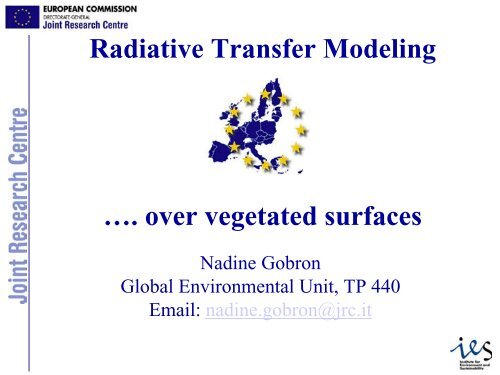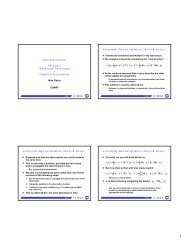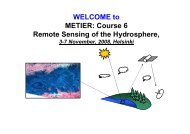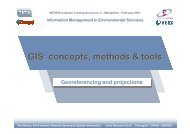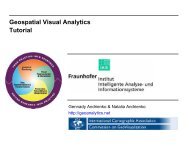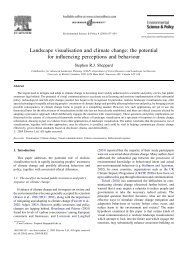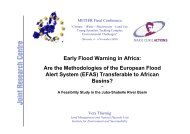Vegetation Radiative Transfer Modelling (Nadine Gobron) - PEER
Vegetation Radiative Transfer Modelling (Nadine Gobron) - PEER
Vegetation Radiative Transfer Modelling (Nadine Gobron) - PEER
You also want an ePaper? Increase the reach of your titles
YUMPU automatically turns print PDFs into web optimized ePapers that Google loves.
<strong>Radiative</strong> <strong>Transfer</strong> Modeling<br />
…. over vegetated surfaces<br />
<strong>Nadine</strong> <strong>Gobron</strong><br />
Global Environmental Unit, TP 440<br />
Email: nadine.gobron@jrc.it<br />
1
Scientific Context<br />
• Earth observing satellites are a unique tool with which to<br />
objectively monitor terrestrial environments at the global scale.<br />
• Temporal changes in the biosphere can be monitored using advanced<br />
methods to interpret remote sensing data.<br />
• The aim of these methods is to provide measurable parameters representing<br />
the state of the terrestrial surfaces.<br />
• These remote sensing products constitute reliable indicators of the<br />
evolution of the living biosphere.<br />
• In practice, one does acquire the measurements from the satellite, and would<br />
like to know what is going on in the environment:<br />
This is the inverse problem: Knowing the value of the electromagnetic<br />
measurements gathered in space, how can we derive the properties of the<br />
environment that were responsible for the radiation to reach the sensor?<br />
2
Satellites have different “eyes”<br />
Swath 1150 km – Res. 300m to 1.2 km<br />
Swath 2800 km – Res. 1.5 km<br />
MERIS/ENVISAT<br />
Swath 2330 km – Res. 250m to 1.1 km<br />
MODIS/TERRA<br />
Swath 200 km – Res. 500m<br />
MOS/IRS P3<br />
79 km<br />
Credit: NASA/GSFC/LaRC/JPL MISR Team<br />
Swath 979 km – Res. 275 m to 1.0 km<br />
SeaWiFS/OrbView<br />
3
How is remote sensing exploited?<br />
• The signals detected by the sensors are immediately converted<br />
into digital numbers and transmitted to dedicated receiving<br />
stations, where these data are heavily processed.<br />
• The effective exploitation of remote sensing data to reliably<br />
generate useful, pertinent information hinges on the<br />
availability and performance of specific tools and techniques<br />
of data analysis and interpretation.<br />
• A variety of mathematical models can be used for this<br />
purpose; they are implemented as computer codes that read the<br />
data or intermediary products and ultimately lead to the<br />
generation of products and services usable in specific<br />
applications…. User is happy !<br />
4
Model of radiation transfer<br />
• Since space borne instruments can only measure the properties<br />
of electromagnetic waves emitted or scattered by the Earth,<br />
scientists need first to understand where these waves originate<br />
from, how they interact with the environment, and how they<br />
propagate towards the sensor.<br />
• To this effect, they develop models of radiation transfer,<br />
assuming that everything is known about the sources of<br />
radiation and the environment, and calculate the properties of<br />
the radiation field as the sensor should measure them. This is<br />
the so-called direct problem.<br />
5
<strong>Radiative</strong> <strong>Transfer</strong> Modeling<br />
• In solar domain, radiation transfer models are tools to<br />
represent the scattering and absorption of radiation by<br />
scattering elements/centers. They should satisfy energy<br />
conservation.<br />
• Spectral properties are depending<br />
on the geophysical medium:<br />
atmosphere, ocean, soil,<br />
or vegetation<br />
• Monograph dealing with<br />
RT problems in geophysics<br />
(Chandrasekhar (1960),<br />
Van de Hulst (1957),<br />
Lenoble (1993), Hapke (1993),<br />
Liou (1980) etc…) mainly concentrate on mathematical<br />
issues related to solving equations.<br />
• Rather than discussing the solving of approximate equations<br />
applicable to realistic geophysical situations, we will<br />
concentrate on exact and light mathematical treatment of a<br />
simplified physical system…<br />
6
Outline<br />
• <strong>Radiative</strong> <strong>Transfer</strong> Equations<br />
• <strong>Radiative</strong> <strong>Transfer</strong> Modeling for vegetation<br />
canopy.<br />
• Inversion problem for the retrieval of land<br />
products with actual remote sensing data.<br />
7
<strong>Radiative</strong> <strong>Transfer</strong> Equations (1)<br />
• Exact and light mathematical treatment of a simplified<br />
physical system<br />
• The system under consideration will have the following<br />
properties:<br />
– A continuous scattering-absorbing medium, infinite in lateral extent, bounded<br />
by two parallel planes, i.e. a plane-parallel medium.<br />
– Radiation can be scattered in only two directions, upward and downward.<br />
z=0<br />
z<br />
z+Δz<br />
z=z h<br />
Pinty, B. and M. M. Verstraete (1998) `Introduction to Radiation <strong>Transfer</strong> Modeling in Geophysical Media’, in From Urban<br />
Air Pollution to Extra-Solar Planets, ERCA Volume 3 Edited by C. Boutron, EDP Sciences, Les Ulis, France, 67-87.<br />
8
• The system under consideration will have the following<br />
properties:<br />
– Radiation or “ensemble of photons” is emitted by sources outside the<br />
medium only.<br />
– The amount of mean monochromatic radiant energy traveling upward<br />
and downward that crosses a unit area per unit time is an intensity<br />
noted I [Wm -2 sr -1 ].<br />
<strong>Radiative</strong> <strong>Transfer</strong> Equations (1)<br />
z=0<br />
I (z)<br />
I (z+Δz)<br />
I (z)<br />
I (z+Δz)<br />
z<br />
z+Δz<br />
z=z h<br />
Pinty, B. and M. M. Verstraete (1998) `Introduction to Radiation <strong>Transfer</strong> Modeling in Geophysical Media’, in From Urban<br />
Air Pollution to Extra-Solar Planets, ERCA Volume 3 Edited by C. Boutron, EDP Sciences, Les Ulis, France, 67-87.<br />
9
Basic Processes (1)<br />
Scattering<br />
“A physical process by which an ensemble of particles<br />
immerged into an electromagnetic radiation field remove<br />
energy from the incident waves to re-irradiate this energy into<br />
other directions”<br />
Absorption<br />
“A physical process by which an ensemble of particles<br />
immerged into an electromagnetic radiation field remove<br />
energy from the incident waves to convert this energy in a<br />
different form”<br />
Extinction<br />
“A physical process by which an ensemble of particles<br />
immerged into an electromagnetic radiation field remove<br />
energy from the incident waves to attenuate the energy of this<br />
incident wave”<br />
10
Basic Processes (2)<br />
•The upward and downward intensities change along the vertical coordinate z<br />
in the medium according to the volumetric (individual cross-sections times the<br />
number per unit volume) coefficients of absorption, K (in m -1 ) and scattering S<br />
(in m -1 )<br />
•Thus 1/S (1/K) have dimensions of length and may be interpreted as the<br />
absorption (scattering) mean free paths, i.e. the average distance between<br />
absorption (scattering) events.<br />
z=0<br />
I (z)<br />
I (z+Δz)<br />
I (z)<br />
I (z+Δz)<br />
z<br />
z+Δz<br />
z=z h<br />
11
I (z)<br />
I (z+Δz)<br />
Conservation of radiant energy<br />
for I in a slab Δz<br />
I (z)<br />
I (z+Δz)<br />
z=0<br />
z<br />
z+Δz<br />
z=z h<br />
P is the probability<br />
that a photon<br />
directed upward is<br />
scattered downward<br />
I<br />
↓<br />
(z)<br />
+<br />
SΔzP<br />
↑↓<br />
I<br />
↑<br />
(z<br />
+<br />
Δz)<br />
=<br />
P is the probability<br />
that a photon<br />
directed downward<br />
is scattered upward<br />
↓<br />
↓↑<br />
KΔ zI (z) + SΔzP<br />
I (z) + I (z +<br />
↓<br />
↓<br />
Δz)<br />
coefficients of absorption, K (in m -1 ) and scattering S (in m -1 )<br />
12
Conservation of radiant energy for I in a slab Δz<br />
z=0<br />
I (z)<br />
I (z+Δz)<br />
I (z)<br />
I (z+Δz)<br />
z<br />
z+Δz<br />
z=z h<br />
I<br />
↑<br />
(z<br />
+<br />
Δz)<br />
+<br />
SΔzP<br />
↓↑<br />
I<br />
↓<br />
(z)<br />
=<br />
KΔzI<br />
↑<br />
(z<br />
↑↓<br />
+ Δz)<br />
+ SΔzP<br />
I (z + Δz)<br />
↑<br />
+<br />
I<br />
↑<br />
(z)<br />
coefficients of absorption, K (in m -1 ) and scattering S (in m -1 )<br />
13
Conservation of radiant energy in a slab Δz<br />
We obtain the two-stream equations<br />
∂I<br />
↓<br />
∂z<br />
(z)<br />
= −KI<br />
↓<br />
(z)<br />
−<br />
SP<br />
↓↑<br />
I<br />
↓<br />
(z)<br />
+<br />
SP<br />
↑↓<br />
I<br />
↑<br />
(z)<br />
∂I<br />
↑<br />
∂z<br />
(z)<br />
= + KI<br />
↑<br />
(z)<br />
+<br />
SP<br />
↑↓<br />
I<br />
↑<br />
(z)<br />
−<br />
SP<br />
↓↑<br />
I<br />
↓<br />
(z)<br />
coefficients of absorption, K (in m -1 ) and scattering S (in m -1 )<br />
Pinty, B. and M. M. Verstraete (1998) `Introduction to Radiation <strong>Transfer</strong> Modeling in Geophysical Media’, in From Urban<br />
Air Pollution to Extra-Solar Planets, ERCA Volume 3 Edited by C. Boutron, EDP Sciences, Les Ulis, France, 67-87.<br />
14
Asymmetry factor for scattering processes<br />
•We have for isotropic medium:<br />
P<br />
↑↓ = P ↓↑<br />
•The asymmetry factor g is a single number, defined as the<br />
mean cosine of the scattering angle (-1 or +1 in our case):<br />
↓↓<br />
↓↑<br />
g<br />
= ( + 1)P + ( −1)<br />
P<br />
•Typically: g = +1 for strict downward scattering,<br />
g=-1 for strict upward scattering and,<br />
g=0 for isotropic scattering.<br />
•For the above set of equations, we have:<br />
P<br />
↑↓<br />
P<br />
↓↓ = P ↑↑<br />
↑↑ ↓↑ ↓↓<br />
+ P = P + P = 1<br />
P<br />
↑↓ = P<br />
↓↑ = (1 − g) / 2<br />
P ↑↑ = P<br />
↓↓ = (1 + g) / 2<br />
15
Single scattering albedo<br />
•Normalization of the radiation transport equations by the<br />
extinction factor E=S+K gives :<br />
↓<br />
1 ∂I<br />
(z) K ↓ S ↓↑ ↓ S ↑↓ ↑<br />
= − I (z) − P I (z) + P I (z)<br />
E ∂z<br />
E E E<br />
which can be rewritten as:<br />
1 ↓<br />
↓<br />
↑<br />
E<br />
↓<br />
∂I<br />
(z)<br />
∂z<br />
= −I<br />
(z) +<br />
(1 + g)<br />
ω<br />
2<br />
(z) +<br />
(1 − g)<br />
ω<br />
2<br />
↑<br />
1 ∂I<br />
(z) ↑ (1 + g) ↑ (1 − g) ↓<br />
= + I (z) − ω I (z) − ω I (z)<br />
E ∂z<br />
2<br />
2<br />
where is called the single scattering albedo<br />
S S<br />
ω = =<br />
S + K E<br />
expressing the probability for the photons to be scattered.<br />
Pinty, B. and M. M. Verstraete (1998) `Introduction to Radiation <strong>Transfer</strong> Modeling in Geophysical Media’, in From Urban<br />
Air Pollution to Extra-Solar Planets, ERCA Volume 3 Edited by C. Boutron, EDP Sciences, Les Ulis, France, 67-87.<br />
I<br />
I<br />
(z)<br />
16
Single scattering albedo<br />
↓<br />
∂I<br />
(z)<br />
E ∂z<br />
↑<br />
∂I<br />
(z)<br />
E ∂z<br />
1 ↓<br />
↓<br />
↑<br />
= −I<br />
= + I<br />
(1 + g)<br />
(z) + ω I<br />
2<br />
(1 + g)<br />
(z) − ω I<br />
2<br />
(1 − g)<br />
(z) + ω I<br />
2<br />
(1 − g)<br />
(z) − ω I<br />
2<br />
1 ↑<br />
↑<br />
↓<br />
(z)<br />
(z)<br />
ω =<br />
S<br />
S + K<br />
=<br />
S<br />
E<br />
• Single scattering albedo ω =0 for total absorption (no<br />
scattering)<br />
• Single scattering albedo ω =1 for total or conservative<br />
scattering (no absorption)<br />
Pinty, B. and M. M. Verstraete (1998) `Introduction to Radiation <strong>Transfer</strong> Modeling in Geophysical Media’, in From Urban<br />
Air Pollution to Extra-Solar Planets, ERCA Volume 3 Edited by C. Boutron, EDP Sciences, Les Ulis, France, 67-87.<br />
17
Optical thickness<br />
• The variable physical depth can be multiplied by the<br />
optical factor S+K=E to transform into an optical thickness<br />
↓<br />
∂I<br />
(z)<br />
∂τ<br />
τ<br />
= −I<br />
↓<br />
z<br />
∂z<br />
= ∫ (S + K) ∂z<br />
0<br />
(1 + g)<br />
(z) + ω<br />
2<br />
I<br />
↓<br />
(1 − g)<br />
(z) + ω<br />
2<br />
I<br />
↑<br />
(z)<br />
∂τ<br />
(1)<br />
↑<br />
∂I<br />
(z)<br />
∂τ<br />
= + I<br />
↑<br />
(z)<br />
−<br />
ω<br />
(1 + g)<br />
2<br />
I<br />
↑<br />
(z)<br />
−<br />
ω<br />
(1 − g)<br />
2<br />
I<br />
↓<br />
(z)<br />
(2)<br />
These last equations are typical two-stream equations<br />
for the system.<br />
Pinty, B. and M. M. Verstraete (1998) `Introduction to Radiation <strong>Transfer</strong> Modeling in Geophysical Media’, in From Urban<br />
Air Pollution to Extra-Solar Planets, ERCA Volume 3 Edited by C. Boutron, EDP Sciences, Les Ulis, France, 67-87.<br />
18
Two-stream equations<br />
• In a more compact form [with (1) - (2) and (1)+(2)]:<br />
↓ ↑<br />
∂( I − I )<br />
↓ ↑<br />
= −(1<br />
− ω)(I<br />
+ I )<br />
∂τ<br />
↓ ↑<br />
∂( I + I )<br />
↓ ↑<br />
= −(1<br />
− ωg)(I<br />
− I )<br />
∂τ<br />
Key variables to represent the radiative transfer processes are:<br />
• ω : the single scattering albedo<br />
• g : the asymmetry factor of the phase function<br />
• τ : the optical thickness of the medium<br />
Pinty, B. and M. M. Verstraete (1998) `Introduction to Radiation <strong>Transfer</strong> Modeling in Geophysical Media’, in From Urban<br />
Air Pollution to Extra-Solar Planets, ERCA Volume 3 Edited by C. Boutron, EDP Sciences, Les Ulis, France, 67-87.<br />
19
Extension to N Flux (1)<br />
• These equations can be extended to N flux to obtain N<br />
coupled differential equations including N+1 terms on<br />
the right side.<br />
•The first term represents the extinction and the N<br />
remaining terms represent all the possible ways in which<br />
radiation is scattering into one direction Ω from all other<br />
directions Ω’.<br />
•In the limit when N goes to infinity, sums become<br />
integrals and the set of equations collapses into a single<br />
integro-differential equation:<br />
∂I<br />
( z,<br />
Ω)<br />
− μ<br />
∂τ<br />
+ ~ σ ~<br />
e<br />
( z,<br />
Ω)<br />
I(<br />
z,<br />
Ω)<br />
= σ s<br />
( z,<br />
Ω'<br />
→ Ω)<br />
I(<br />
z,<br />
Ω')<br />
dΩ'<br />
Pinty, B. and M. M. Verstraete (1998) `Introduction to Radiation <strong>Transfer</strong> Modeling in Geophysical Media’, in From Urban<br />
Air Pollution to Extra-Solar Planets, ERCA Volume 3 Edited by C. Boutron, EDP Sciences, Les Ulis, France, 67-87.<br />
∫<br />
4Π<br />
20
Extension to N Flux (2)<br />
In the limit when N goes to infinity, sums become integrals and<br />
the set of equations collapses into a single integro-differential<br />
equation:<br />
∂I<br />
( z,<br />
Ω)<br />
− μ<br />
∂τ<br />
+ ~ σ ~<br />
e<br />
( z,<br />
Ω)<br />
I(<br />
z,<br />
Ω)<br />
= σ s<br />
( z,<br />
Ω'<br />
→ Ω)<br />
I(<br />
z,<br />
Ω')<br />
dΩ'<br />
I (z, Ω ) represents the intensity (W m -2 sr -1 ) at point z in the<br />
exiting direction Ω,<br />
σ e (m -1 ) and σ s (m -1 sr -1 ) are the extinction and differential<br />
scattering coefficients, respectively, taken at the same point z<br />
along the direction Ω.<br />
∫<br />
4Π<br />
Pinty, B. and M. M. Verstraete (1998) `Introduction to Radiation <strong>Transfer</strong> Modeling in Geophysical Media’, in From Urban<br />
Air Pollution to Extra-Solar Planets, ERCA Volume 3 Edited by C. Boutron, EDP Sciences, Les Ulis, France, 67-87.<br />
21
Vertical radiative coupling between<br />
geophysical media<br />
Atmosphere<br />
<strong>Vegetation</strong><br />
Soil<br />
Upper limit (1)<br />
RTE<br />
Lower Limit (1)<br />
Upper limit (2)<br />
RTE<br />
Lower Limit (2)<br />
Upper limit (3)<br />
RTE<br />
Lower Limit (3)<br />
Z A<br />
Z V<br />
Z S<br />
In each medium, the transfer of radiation may be represented<br />
by the following approximate equation:<br />
∂<br />
[ −μ<br />
+ ~ σ ~<br />
e<br />
( z,<br />
Ω,<br />
ΩO)]<br />
I(<br />
z,<br />
Ω)<br />
= ∫σ<br />
s<br />
( z,<br />
Ω'<br />
→ Ω)<br />
I(<br />
z,<br />
Ω')<br />
dΩ'<br />
∂τ<br />
Extinction coefficient<br />
Differential<br />
4Π<br />
scattering coefficient<br />
Pinty, B. and M. M. Verstraete (1998) `Introduction to Radiation <strong>Transfer</strong> Modeling in Geophysical Media’, in From Urban<br />
Air Pollution to Extra-Solar Planets, ERCA Volume 3 Edited by C. Boutron, EDP Sciences, Les Ulis, France, 67-87.<br />
22
Atmosphere<br />
<strong>Vegetation</strong><br />
Soil<br />
Vertical radiative coupling between<br />
geophysical media<br />
•Non oriented small scatterers<br />
•Infinite number of scatterers<br />
•Low density turbid medium<br />
•Oriented finite-size scatterers<br />
•Finite number of scatterers<br />
•Dense discrete medium<br />
•Oriented small-size scatterers<br />
•Infinite number of clustered scatterers<br />
•Compact semi-infinite medium<br />
Pinty, B. and M. M. Verstraete (1998) `Introduction to Radiation <strong>Transfer</strong> Modeling in Geophysical Media’, in From Urban<br />
Air Pollution to Extra-Solar Planets, ERCA Volume 3 Edited by C. Boutron, EDP Sciences, Les Ulis, France, 67-87.<br />
23
Vertical radiative coupling between<br />
geophysical media<br />
The description of the interaction of a radiation field with a<br />
layered geophysical medium implies the solution of<br />
radiation transfer equations and the specification of<br />
appropriate boundary conditions<br />
I<br />
↓<br />
Atmosphere<br />
Soil<br />
( z ta<br />
, Ω)<br />
= I0δ<br />
( Ω − Ω<br />
o<br />
)<br />
I ↑ ( z , Ω)<br />
=<br />
∞<br />
0<br />
I<br />
↑<br />
( , Ω)<br />
↑<br />
1<br />
' ↓<br />
' '<br />
I ( z<br />
ba<br />
, Ω ) = ( , Ω , Ω ) (<br />
,<br />
Ω ) | | Ω<br />
Π<br />
∫ γ<br />
v<br />
z<br />
ba<br />
I z<br />
ba<br />
μ d<br />
2 Π<br />
↓<br />
↓<br />
− τ<br />
a ↓<br />
I ( z<br />
tv<br />
, Ω ) = I ( z<br />
ta ,<br />
Ω ) exp[ ] + I<br />
d<br />
( z<br />
ba<br />
, Ω )<br />
| μ<br />
0<br />
|<br />
<strong>Vegetation</strong><br />
↑<br />
1<br />
' ↓<br />
' ' '<br />
I ( z<br />
bv<br />
, Ω ) = ( , Ω , Ω ) (<br />
,<br />
Ω ) | | Ω<br />
Π<br />
∫ γ<br />
s<br />
z<br />
bv<br />
I z<br />
bv<br />
μ d<br />
2 Π<br />
Pinty, B. and M. M. Verstraete (1998) `Introduction to Radiation <strong>Transfer</strong> Modeling in Geophysical Media’, in From Urban<br />
Air Pollution to Extra-Solar Planets, ERCA Volume 3 Edited by C. Boutron, EDP Sciences, Les Ulis, France, 67-87.<br />
z a<br />
'<br />
Z a<br />
Z V<br />
Z S<br />
24
Outline<br />
• <strong>Radiative</strong> <strong>Transfer</strong> Equations<br />
• <strong>Radiative</strong> <strong>Transfer</strong> Modeling for vegetation<br />
canopy.<br />
• Inversion problem for the retrieval of land<br />
products with actual remote sensing data.<br />
25
Representation of vegetation canopy<br />
‘Oriented’ scatterers elements in a finite volume<br />
turbid medium<br />
» Leaves are point-like scatterers<br />
discrete medium<br />
» Leaves are finited-size scatterers<br />
26
Discrete canopy: 1D representation<br />
Df<br />
H<br />
Geometrical Parameters in 1D representation:<br />
Height of canopy, Size of a single leaf & Leaves<br />
orientation (leaf angle distribution)<br />
<strong>Gobron</strong>, N et. al. (1997) ‘A semi-discrete model for the scattering of light by vegetation’, Journal of Geophysical Research,<br />
102, 9431-9446.<br />
27
<strong>Vegetation</strong> ‘Optical Depth’<br />
• Leaf Area Index (LAI) is a quantitative<br />
measure of the amount of live green leaf<br />
material present in the canopy per unit ground<br />
surface.<br />
• It is defined as the total one-sided area of all<br />
leaves in the canopy within a defined region.<br />
N N<br />
LAI = ∑ λ ∑ i = niai<br />
i=<br />
1 i=<br />
1<br />
N = # of layers<br />
a i = leaf surface<br />
n i = # leaves /m2<br />
<strong>Gobron</strong>, N et. al. (1997) ‘A semi-discrete model for the scattering of light by vegetation’, Journal of Geophysical Research,<br />
102, 9431-9446.<br />
28
<strong>Vegetation</strong> ‘Optical Depth’<br />
• Leaf Area Index (LAI) is a quantitative<br />
measure of the amount of live green leaf<br />
material present in the canopy per unit ground<br />
surface.<br />
• It is defined as the total one-sided area of all<br />
leaves in the canopy within a defined region.<br />
H : Height of canopy [m]<br />
LAI = H.Δ<br />
Δ : Leaf Area Density [m 2 /m 3 ]<br />
<strong>Gobron</strong>, N et. al. (1997) ‘A semi-discrete model for the scattering of light by vegetation’, Journal of Geophysical Research,<br />
102, 9431-9446.<br />
29
Geometrical System<br />
Ωo<br />
θ<br />
Ω<br />
φ<br />
North<br />
φ ο<br />
H<br />
θ ο<br />
z<br />
<strong>Gobron</strong>, N et. al. (1997) ‘A semi-discrete model for the scattering of light by vegetation’, Journal of Geophysical Research,<br />
102, 9431-9446.<br />
30
~ Extinction coefficient σ ( z,<br />
Ω,<br />
ΩO)<br />
e<br />
∂<br />
[ −μ<br />
+ ~ σ ~<br />
e<br />
( z,<br />
Ω,<br />
ΩO)]<br />
I(<br />
z,<br />
Ω)<br />
= ∫σ<br />
s<br />
( z,<br />
Ω'<br />
→ Ω)<br />
I(<br />
z,<br />
Ω')<br />
dΩ'<br />
∂τ<br />
We assume that the canopy consists of plane leaves with a leaf area<br />
density λ(z) defined to be the total one-sided leaf area per unit volume<br />
at depth z.<br />
The probability that a leaf has a normal Ω<br />
directed away from the top surface, in a unit<br />
solid angle about<br />
Ω l<br />
is given by the leaf-normal distribution function<br />
which is normalized as<br />
1<br />
2π<br />
∫<br />
2π<br />
dφ<br />
l<br />
1<br />
∫<br />
0<br />
dμ<br />
l<br />
g<br />
l<br />
4Π<br />
l<br />
( z,<br />
Ω<br />
⎜<br />
⎛<br />
⎝<br />
l<br />
θ<br />
)<br />
l<br />
g<br />
, ϕ<br />
l<br />
=<br />
l<br />
⎟<br />
⎞<br />
⎠<br />
( z,<br />
Ωl)<br />
1<br />
Ω L<br />
plate model 31
Extinction coefficient<br />
We now consider photons at a depth z traveling in direction Ω.<br />
The extinction coefficient is then the probability, per unit path length,<br />
that the photon hits a leaf, i.e., the probability that a photon while<br />
traveling a distance ds along Ω is intercepted by a leaf divided by the<br />
distance ds.<br />
e<br />
( z, ) G( z,<br />
) ( z)<br />
σ Ω = Ω λ<br />
Where the geometry factor G is the fraction of the total leaf area (per<br />
unit volume of the canopy) that is perpendicular to Ω<br />
1<br />
G ( z,<br />
) = ( Ω ) | Ω • Ω |<br />
l l<br />
2π<br />
2π<br />
Ω ∫ g<br />
d<br />
l<br />
Ω<br />
l<br />
Ross J. (1981) ‘The Radiation Regime and Architecture of Plant Stands’, The Hague-Boston-London: Dr. W.Junk<br />
Publishers, 391 pp.<br />
32
Leaf Orientations<br />
<strong>Vegetation</strong> foliage features characteristic leaf-normal distributions,<br />
g(Ω L ) with preferred:<br />
• azimuthal orientations, g(φ L )<br />
• zenithal orientations, g(θ L ):<br />
‣ erectophile (grass) (90 o )<br />
‣ planophile (water cress) (0 o )<br />
‣ plagiophile (45 o )<br />
‣ extremophile (0 o and 90 o )<br />
‣ uniform/spherical (all)<br />
• time varying orientations:<br />
‣ heliotropism (sunflower)<br />
‣ para-heliotropism<br />
Ross J. (1981) ‘The Radiation Regime and Architecture of Plant Stands’, The Hague-Boston-London: Dr. W.Junk<br />
Publishers, 391 pp.<br />
33
Scattering properties of leaves<br />
• Once the radiation is intercepted by the vegetation elements, it<br />
is scattered in directions determined by the leaf orientations and<br />
the leaf phase function<br />
Ω<br />
• Leaf reflection and transmission<br />
depend primarily on wavelength,<br />
plant species, growth condition,<br />
age and position in canopy.<br />
• Directionality of leaf scattering<br />
depends on the leaf surface<br />
roughness, and the percentage<br />
of diffusely scattered photons<br />
from leaf interior.<br />
Ω<br />
Ω L<br />
plate model<br />
‣ Plate models often assume Bi-Lambertian scattering properties:<br />
- radiation is scattered according to cosine law: | Ω L · Ω |<br />
- magnitude depends on leaf reflection and transmission values<br />
34
Leaf scattering properties<br />
• Leaf scattering function for classical plate scattering<br />
model<br />
f ( Ω<br />
'<br />
→<br />
Ω,<br />
Ω<br />
l<br />
)<br />
=<br />
r<br />
l<br />
|<br />
Ω • Ω |<br />
l<br />
/<br />
π<br />
if ( Ω • Ω )( Ω<br />
l<br />
'<br />
• Ω )<br />
l<br />
<<br />
0<br />
f ( Ω<br />
'<br />
→<br />
Ω,<br />
Ω<br />
l<br />
)<br />
=<br />
t<br />
l<br />
|<br />
Ω • Ω |<br />
l<br />
/<br />
π<br />
if ( Ω • Ω )( Ω<br />
l<br />
'<br />
• Ω )<br />
l<br />
><br />
0<br />
Where r l and t l are the fraction of intercepted energy<br />
which are reflected (transmitted) following a simple<br />
cosine distribution law around the normal to the<br />
leaves.<br />
35
Reflectance measurements of leaves<br />
Summer - Autumn - Winter<br />
60<br />
40<br />
20<br />
Chlorophyls<br />
Anthocyans<br />
Tannins<br />
0<br />
200 600 1000 1400 1800 2200 2600<br />
nm<br />
brown leaf red leaf green leaf<br />
Source: B. Hosgood<br />
36
Canopy scattering phase function<br />
• Leaf properties are assumed to be the same throughout<br />
the canopy, we have<br />
1<br />
π<br />
1<br />
π<br />
Γ(z<br />
k<br />
Γ(<br />
Ω<br />
, Ω<br />
'<br />
'<br />
→<br />
→<br />
Ω)<br />
Ω)<br />
≡<br />
≡<br />
1<br />
2π<br />
1 '<br />
Γ(<br />
Ω → Ω)<br />
π<br />
∫<br />
2π<br />
g( Ω<br />
l<br />
) | Ω<br />
'<br />
• Ω | f ( Ω<br />
'<br />
→<br />
Ω,<br />
Ω<br />
l<br />
)dΩ<br />
l<br />
g (Ω L ) is the probability function for the leaf normal distribution Ω L<br />
f is the leaf phase function (when integrated over all exit photons<br />
directions, yields single scattering albedo ω).<br />
Shultis, J. K. and Myneni, R. B. (1988) ‘<strong>Radiative</strong> transfer in vegetation canopies with an isotropic scattering’, Journal of<br />
quantitative spectroscopy and radiative transfer 39: 115-- 129.<br />
37<br />
Knyazihin et. al. (1992) ‘Interaction of Photons in a Canopy of Finite Dimensional Leaves’, Remote Sens. Envir., 39:61-74.
Specific Effects<br />
•The presence of finite size scatterers implies that the radiation<br />
interception process by the leaves will not follow a continuous<br />
scheme, and in particular that radiation will be allowed to<br />
travel unimpeded within the free space between the scatterers.<br />
•Since extinction occurs only at discrete locations, some of the<br />
radiation emerging from an arbitrary source, located inside or<br />
outside the canopy, any occasionally travel without any<br />
interaction in this canopy, depending on the shape and size of<br />
free space between these leaves.<br />
Verstraete, M. M et. al. (1990) 'A physical model of the bidirectional reflectance of vegetation canopies; Part 1: Theory', Journal of<br />
Geophysical Research, 95, 11,755-11,765.<br />
<strong>Gobron</strong>, N et. al. (1997) ‘A semi-discrete model for the scattering of light by vegetation’, Journal of Geophysical Research, 102, 38<br />
9431-9446.
•When the radiation is scattered<br />
back in the direction from which it<br />
originates, the probability of further<br />
interaction with the canopy is lower<br />
than in other scattering directions.<br />
•In case of RS measurements<br />
outside the canopy, this give rise to<br />
a relative increase in the value in<br />
the backscattering direction which<br />
is knows as the hot-spot<br />
phenomenon.<br />
Hot-spot Effects<br />
Verstraete, M. M et. al. (1990) 'A physical model of the bidirectional reflectance of vegetation canopies; Part 1: Theory', Journal of<br />
Geophysical Research, 95, 11,755-11,765.<br />
<strong>Gobron</strong>, N et. al. (1997) ‘A semi-discrete model for the scattering of light by vegetation’, Journal of Geophysical Research, 102, 39<br />
9431-9446.
Hot-spot Effects<br />
Extinction coefficient is modified adding hot-spot<br />
scale factor:<br />
σ e (z, Ω, Ω 0 ) = Λ(z) · G(Ω)· O(z, Ω, Ω 0 )<br />
Ω 0<br />
Ω = Ω 0<br />
Ω<br />
Turbid canopy representation: 1-D<br />
-90 -45 0 45 90<br />
observation zenith angle [degree]<br />
illuminated leaf<br />
Verstraete, M. M et. al. (1990) 'A physical model of the bidirectional reflectance of vegetation canopies; Part 1: Theory', Journal of<br />
Geophysical Research, 95, 11,755-11,765.<br />
<strong>Gobron</strong>, N et. al. (1997) ‘A semi-discrete model for the scattering of light by vegetation’, Journal of Geophysical Research, 102, 40<br />
9431-9446.<br />
Bi-directional Reflectance Factor (λ= Red)<br />
0.08<br />
0.06<br />
0.04<br />
0.02<br />
0.00<br />
1-D’<br />
1-D
Separation of Scattering Order<br />
ρ ( z0,<br />
Ω,<br />
Ω0)<br />
= ρ 0 (z0,<br />
Ω,<br />
Ω0)<br />
+ ρ 1 (z0,<br />
Ω,<br />
Ω0)<br />
+ ρ M (z0,<br />
Ω,<br />
Ω0)<br />
• Uncollided intensity<br />
• Single Collided intensity<br />
• Multiple scattering intensity<br />
<strong>Gobron</strong>, N et. al. (1997) ‘A semi-discrete model for the scattering of light by vegetation’, Journal of Geophysical<br />
Research, 102, 9431-9446.<br />
41
Uncollided intensity (1)<br />
Downward uncollided intensity at level z k<br />
Where<br />
I<br />
0<br />
↓<br />
(z<br />
k<br />
, Ω<br />
0<br />
) =<br />
I<br />
s<br />
⎡<br />
⎢1<br />
− λ<br />
⎣<br />
0<br />
Is<br />
= I (z0,<br />
Ω0)<br />
δ(<br />
Ω − Ω0)<br />
G( Ω0)<br />
⎤<br />
⎥<br />
| μ | ⎦<br />
0<br />
k<br />
is the incoming<br />
collimated beam at the top of canopy<br />
Probability that a light ray within this beam is transmitted<br />
downward in the same direction through the first k layers<br />
<strong>Gobron</strong>, N et. al. (1997) ‘A semi-discrete model for the scattering of light by vegetation’, Journal of Geophysical<br />
Research, 102, 9431-9446.<br />
42
I<br />
0<br />
↑<br />
(H, Ω,<br />
Ω<br />
0<br />
)<br />
=<br />
1<br />
π<br />
γ<br />
s<br />
Uncollided intensity (2)<br />
The radiation scattered by the soil, which provides the lower<br />
radiative boundary condition of the canopy system, for<br />
uncollided radiation is given by:<br />
γ<br />
( H, Ω,<br />
Ω0)<br />
(H, Ω,<br />
Ω<br />
0<br />
)<br />
|<br />
μ<br />
0<br />
|<br />
I<br />
s<br />
⎡<br />
⎢1<br />
− λ<br />
⎣<br />
G( Ω0)<br />
⎤<br />
⎥<br />
| μ | ⎦<br />
Where s<br />
denotes the bidirectional reflectance<br />
factor of the soil at the bottom of canopy.<br />
0<br />
K<br />
I<br />
K<br />
k<br />
∏ + 1<br />
1<br />
⎡ G( Ω ⎤ ⎡<br />
↑ =<br />
⎢ −<br />
0)<br />
⎢ −<br />
' G( Ω<br />
0 (zk,<br />
Ω,<br />
Ω<br />
)<br />
0)<br />
γs(H,<br />
Ω,<br />
Ω0)<br />
| μ0<br />
| Is<br />
1 λ<br />
1 λK<br />
π<br />
| μ0<br />
| j=<br />
K μ<br />
⎣<br />
⎥<br />
⎦<br />
⎣<br />
⎤<br />
⎥<br />
⎦<br />
<strong>Gobron</strong>, N et. al. (1997) ‘A semi-discrete model for the scattering of light by vegetation’, Journal of Geophysical<br />
Research, 102, 9431-9446.<br />
43
Uncollided BRF<br />
Applying last equation at the top of canopy and normalized by<br />
the intensity of the source of incoming direct solar radiation as<br />
well as by the reflectance of a Lambertian surface illuminated<br />
and observed under identical conditions (|μ 0 |/π) yields the<br />
contribution to the bidirectional reflectance factor due to this<br />
uncollided radiation, namely:<br />
⎡ G( Ω0)<br />
⎤ ⎡ ' G( Ω)<br />
⎤<br />
ρ 0 (z0,<br />
Ω,<br />
Ω0)<br />
= γs(H,<br />
Ω,<br />
Ω0)<br />
⎢1<br />
− λ ⎥ 1<br />
K<br />
|<br />
0<br />
|<br />
⎢ − λ ⎥<br />
⎣ μ ⎦ ⎣ μ ⎦<br />
K<br />
K<br />
<strong>Gobron</strong>, N et. al. (1997) ‘A semi-discrete model for the scattering of light by vegetation’, Journal of Geophysical<br />
Research, 102, 9431-9446.<br />
44
Uncollided BRF in Principal Plan<br />
Solar Zenith Angle: 20 [deg]<br />
Solar Azimuth Angle: 0 [deg]<br />
Radius:<br />
0.05 [m]<br />
Leaf Area Index: 3.0 [ m2/m2]<br />
Height of the canopy: 2.0 [ m]<br />
Normal Distribution: Erectophile<br />
Leaf scattering law: Bi-Lambertian<br />
Leaf reflectance: 0.0546<br />
Leaf transmittance: 0.0149<br />
Soil scattering law: Lambertian<br />
Soil reflectance: 0.127<br />
http://rami-benchmark.jrc.it<br />
45
Uncollided BRF in Principal Plan<br />
Solar Zenith Angle: 20 [deg]<br />
Solar Azimuth Angle: 0 [deg]<br />
Radius:<br />
0.05 [m]<br />
Leaf Area Index: 3.0 [ m2/m2]<br />
Height of the canopy: 2.0 [ m]<br />
Normal Distribution: Erectophile<br />
Leaf scattering law: Bi-Lambertian<br />
Leaf reflectance 0.4957<br />
Leaf transmittance 0.4409<br />
Soil scattering law Lambertian<br />
Soil reflectance 0.159<br />
http://rami-benchmark.jrc.it<br />
46
Uncollided BRF in Cross Plan<br />
Solar Zenith Angle: 20 [deg]<br />
Solar Azimuth Angle: 0 [deg]<br />
Radius:<br />
0.05 [m]<br />
Leaf Area Index: 3.0 [ m2/m2]<br />
Height of the canopy: 2.0 [ m]<br />
Normal Distribution: Erectophile<br />
Leaf scattering law: Bi-Lambertian<br />
Leaf reflectance: 0.0546<br />
Leaf transmittance: 0.0149<br />
Soil scattering law: Lambertian<br />
Soil reflectance: 0.127<br />
http://rami-benchmark.jrc.it<br />
47
First collided Intensity (1)<br />
The first collided intensity in downward direction Ω<br />
corresponds to the radiation scattered only once by leaves,<br />
but which has not interacted with the soil.<br />
•Downward source coming from the direct intensity,<br />
attenuated through the first k layers, and scattered by the<br />
leaves according to their optical properties in layer k:<br />
Q<br />
0<br />
↓<br />
(z<br />
k<br />
, Ω,<br />
Ω<br />
•Downward intensity<br />
I<br />
1<br />
↓<br />
(z<br />
k<br />
, Ω,<br />
Ω<br />
0<br />
)<br />
0<br />
)<br />
=<br />
1<br />
1<br />
Γ(<br />
Ω<br />
π<br />
0<br />
→ Ω)I<br />
s<br />
⎡<br />
⎢1<br />
−<br />
⎣<br />
G( Ω0)<br />
⎤<br />
λ ⎥<br />
| μ | ⎦<br />
⎡ −<br />
⎣<br />
k<br />
= ∑<br />
0<br />
Q (zi,<br />
Ω,<br />
Ω0)<br />
λ 1<br />
↓<br />
μ<br />
⎢<br />
i=<br />
1<br />
λ<br />
| μ<br />
<strong>Gobron</strong>, N et. al. (1997) ‘A semi-discrete model for the scattering of light by vegetation’, Journal of Geophysical<br />
Research, 102, 9431-9446.<br />
0<br />
k<br />
G( Ω)<br />
⎤<br />
|<br />
⎥ ⎦<br />
48<br />
k−i
First collided Intensity (2)<br />
The first collided intensity in downward direction Ω<br />
corresponds to the radiation scattered only once by leaves,<br />
but which has not interacted with the soil.<br />
•Downward intensity<br />
I<br />
1<br />
↓<br />
(z<br />
k<br />
, Ω,<br />
Ω<br />
0<br />
)<br />
•Upward intensity<br />
1<br />
⎡ −<br />
⎣<br />
G( Ω)<br />
⎤<br />
|<br />
⎥ ⎦<br />
k<br />
= ∑<br />
0<br />
Q (zi,<br />
Ω,<br />
Ω0)<br />
λ 1<br />
↓<br />
μ<br />
⎢<br />
i=<br />
1<br />
λ<br />
| μ<br />
k−i<br />
I<br />
1<br />
↑<br />
(z<br />
k<br />
, Ω,<br />
Ω<br />
0<br />
)<br />
k+<br />
1<br />
k+<br />
1<br />
1 = ∑{<br />
0<br />
Q (z × ∏<br />
↓ i,<br />
Ω,<br />
Ω0)<br />
λ<br />
μ<br />
i=<br />
K<br />
j=<br />
i<br />
⎡<br />
⎢1<br />
−<br />
⎣<br />
λ<br />
'<br />
i<br />
G( Ω)<br />
⎤⎫<br />
⎥⎬<br />
| μ | ⎦⎭<br />
<strong>Gobron</strong>, N et. al. (1997) ‘A semi-discrete model for the scattering of light by vegetation’, Journal of Geophysical<br />
Research, 102, 9431-9446.<br />
49
Single collided BRF<br />
The contribution to the bidirectional reflectance factor due to<br />
the first collided intensity is obtained after normalizing the<br />
upward intensity I 1<br />
( z<br />
by the incoming<br />
0,<br />
Ω,<br />
Ω )<br />
↑ 0<br />
directional source of radiation at the top of canopy:<br />
ρ ( z<br />
1<br />
0<br />
, Ω,<br />
Ω<br />
0<br />
)<br />
=<br />
Γ<br />
( Ω → Ω )<br />
μ | μ |<br />
0<br />
0<br />
i<br />
1<br />
⎡ G(<br />
Ω ⎤<br />
0)<br />
⎡ ' G(<br />
Ω<br />
∑λ⎢1<br />
− λ ⎥ ⎢1<br />
− λK<br />
i= K | μ0<br />
|<br />
μ<br />
⎣<br />
⎦<br />
⎣<br />
) ⎤<br />
⎥ ⎦<br />
i<br />
<strong>Gobron</strong>, N et. al. (1997) ‘A semi-discrete model for the scattering of light by vegetation’, Journal of Geophysical<br />
Research, 102, 9431-9446.<br />
50
Single Collided BRF in Principal Plan<br />
Solar Zenith Angle: 20 [deg]<br />
Solar Azimuth Angle: 0 [deg]<br />
Radius:<br />
0.05 [m]<br />
Leaf Area Index: 3.0 [ m2/m2]<br />
Height of the canopy: 2.0 [ m]<br />
Normal Distribution: Erectophile<br />
Leaf scattering law: Bi-Lambertian<br />
Leaf reflectance: 0.0546<br />
Leaf transmittance: 0.0149<br />
Soil scattering law: Lambertian<br />
Soil reflectance: 0.127<br />
http://rami-benchmark.jrc.it<br />
51
Single Collided BRF in Cross Plan<br />
Solar Zenith Angle: 20 [deg]<br />
Solar Azimuth Angle: 0 [deg]<br />
Radius:<br />
0.05 [m]<br />
Leaf Area Index: 3.0 [ m2/m2]<br />
Height of the canopy: 2.0 [ m]<br />
Normal Distribution: Erectophile<br />
Leaf scattering law: Bi-Lambertian<br />
Leaf reflectance: 0.0546<br />
Leaf transmittance: 0.0149<br />
Soil scattering law: Lambertian<br />
Soil reflectance: 0.127<br />
http://rami-benchmark.jrc.it<br />
52
Ω•∇I λ<br />
(x,Ω)+G(x,Ω)u L<br />
(x)I λ<br />
(x,Ω)= u L(x)<br />
π<br />
Multiple Scattering<br />
Multiple scattering intensities are computed solving<br />
RT equations using various numerical tools, like:<br />
• Discrete Ordinate Methods<br />
• δ-Eddington method<br />
• Adding-doubling<br />
• Two-streams<br />
∫<br />
4π<br />
Γ λ<br />
(x,Ω→ Ω ′)I λ<br />
(x, Ω ′)d Ω ′<br />
53
Multiple Scattering<br />
http://rami-benchmark.jrc.it<br />
54
Outline<br />
• <strong>Radiative</strong> <strong>Transfer</strong> Equations<br />
• <strong>Radiative</strong> <strong>Transfer</strong> Modeling for vegetation<br />
canopy.<br />
• Inversion problem for the retrieval of land<br />
products with actual remote sensing data.<br />
55
Association of physical<br />
measurements, models & models<br />
representing the biosphere<br />
The process of fitting data, as seen by Subramanian Raman in Science with a Smile.<br />
56
Association of physical<br />
measurements, models & models<br />
representing the biosphere<br />
The process of fitting data, as seen by Subramanian Raman in Science with a Smile.<br />
57
Association of physical<br />
measurements, models & models<br />
representing the biosphere<br />
The process of fitting data, as seen by Subramanian Raman in Science with a Smile.<br />
58
Model Inversion<br />
• In general, the system of equations cannot be solved:<br />
– If K< M, the system is still under-determined<br />
– If K= M, measurements errors may prevent the<br />
identification of the exact solution<br />
– If K> M, the system is over-determined<br />
K depends on space observation strategy<br />
M depends on the RT model<br />
59
Space Observation Strategies<br />
• Mono-directional multi-spectral scanning<br />
sensor on a Sun-synchronous orbit<br />
single view of the same target during a<br />
given day (given Sun zenith angle)<br />
• Spinning sensor on a geostationary orbit<br />
multiple views of the same target during<br />
a given day (various Sun zenith angles)<br />
• Multi-directional multi-spectral sensor on<br />
a Sun-synchronous orbit<br />
60
Space Observation Strategies<br />
Source: http://seawifs.gsfc.nasa.gov/SEAWIFS/SEASTAR/<br />
61
Space Observation Strategies<br />
• Mono-directional multi-spectral scanning<br />
sensor on a Sun-synchronous orbit<br />
single view of the same target during a<br />
given day (given Sun zenith angle)<br />
• Spinning sensor on a geostationary orbit<br />
multiple views of the same target during<br />
a given day (various Sun zenith angles)<br />
62
Overview of MISR<br />
Ref: http://www-misr.jpl.nasa.gov/mission/minst.html<br />
63
Spectral Sensor Properties<br />
SeaWiFS<br />
MISR<br />
MODIS<br />
MERIS<br />
64
Bidirectional Reflectance Factor<br />
at Top Of Canopy : Nadir View<br />
SeaWiFS<br />
MISR<br />
MODIS<br />
MERIS<br />
Semi-discret Model<br />
65
Bidirectional Reflectance Factor<br />
at Top Of Canopy : Nadir View<br />
SeaWiFS<br />
MISR<br />
MODIS<br />
MERIS<br />
Semi-discret Model<br />
66
Bidirectional Reflectance Factor<br />
at Top Of Canopy<br />
lai =8.<br />
lai=4.<br />
lai=2.<br />
lai=1.<br />
lai=5.<br />
lai=3.<br />
lai=1.5<br />
lai=0.5<br />
SeaWiFS<br />
MISR<br />
MODIS<br />
MERIS<br />
Semi-discret Model<br />
67
Bidirectional Reflectance Factor Top Of<br />
Atmosphere: Aerosols Optical Depth<br />
Visibility : 151.58 38.33 : 20.22 7.74 5.11 km<br />
SeaWiFS<br />
MISR<br />
MODIS<br />
MERIS<br />
6S Model<br />
Vermote et al. 1997, IEEE<br />
68
Fraction of Absorbed Photosynthetically<br />
Active Radiation (FAPAR)<br />
I ⇓<br />
TOC<br />
I ⇑<br />
TOC<br />
canopy<br />
I ⇑<br />
S<br />
I ⇓<br />
S<br />
soil<br />
FAPAR = [(I ⇓<br />
TOC<br />
+I ⇑S )–(I ⇑<br />
TOC<br />
+I ⇓S )] / I ⇓<br />
TOC<br />
Monitoring this bio-geophysical variable in time provides important<br />
information on the productivity of the vegetation and permits us to estimate,<br />
for example, the effectiveness of plants to assimilate atmospheric carbon<br />
dioxide.<br />
69
Conceptual approach:<br />
Design of FAPAR algorithm<br />
Measurement in the blue spectral domain (which is more<br />
sensitive to atmospheric optical thickness) is used to<br />
decontaminate the measurements in the red and near-infrared<br />
bands, respectively.<br />
A parametric model is used to remove angular effects.<br />
The two rectified values in red and near-infrared bands are<br />
then combined together to derive the FAPAR value.<br />
Technical approach:<br />
A large set of instrument like data (TOA) are simulated with<br />
radiative transfer model in vegetation and atmosphere.<br />
Optimization of coefficients is achieved to derive three<br />
polynomials formulae.<br />
70
Scheme for the algorithm optimization<br />
~<br />
Radiation <strong>Transfer</strong> Models<br />
BRF TOA BRF TOC<br />
Rectified Red<br />
FAPAR<br />
Angular/Atmospheric effects<br />
ρ(<br />
λ ) =<br />
i<br />
TOA<br />
ρ ( Ω<br />
F(<br />
Ω , Ω , k<br />
~<br />
0<br />
v<br />
0<br />
~<br />
, Ωv,<br />
λi<br />
)<br />
HG<br />
, Ω , ρ<br />
λi<br />
λi<br />
λic<br />
)<br />
Rectified NIR<br />
ρ<br />
Rred<br />
= g1[<br />
ρ(<br />
λblu),<br />
ρ(<br />
λred)]<br />
ρ<br />
Rnir<br />
= g2[<br />
ρ(<br />
λblu),<br />
ρ(<br />
λnir)]<br />
i<br />
~<br />
g [ ρ ( λ ), ρ(<br />
λ )] →<br />
~ ρ<br />
blu<br />
~<br />
i<br />
~<br />
TOC<br />
λ<br />
i<br />
~<br />
~<br />
~<br />
g [ ρ(<br />
λ ), ρ(<br />
λ )] = P(<br />
λ , λ ) / Q(<br />
λ , λ )<br />
n<br />
i<br />
P(<br />
λ , λ ) = l<br />
i<br />
Q(<br />
λ , λ ) = l<br />
i<br />
j<br />
n1<br />
+ l<br />
n5<br />
n6<br />
+ l<br />
FAPAR = g<br />
j<br />
j<br />
n10<br />
0<br />
=<br />
( l<br />
04<br />
i<br />
~<br />
( ρ(<br />
λ ) + l<br />
~<br />
~<br />
~<br />
( ρ<br />
i<br />
~<br />
( ρ(<br />
λ ) + l<br />
j<br />
~<br />
, ρ<br />
n2<br />
n7<br />
ρ(<br />
λ ) ρ(<br />
λ ) + l<br />
01 Rnir<br />
2<br />
Rred<br />
)<br />
)<br />
)<br />
)<br />
2<br />
ρ(<br />
λ ) ρ(<br />
λ )<br />
i<br />
i<br />
Rred<br />
i<br />
l ρ<br />
− ρ<br />
Rnir<br />
j<br />
j<br />
i<br />
2<br />
− l<br />
+<br />
j<br />
+ l<br />
+ l<br />
ρ<br />
n3<br />
n8<br />
n11<br />
~<br />
( ρ(<br />
λ ) + l<br />
~<br />
( ρ(<br />
λ ) + l<br />
− l<br />
02 Rred 03<br />
2<br />
( l05<br />
− ρ<br />
Rnir<br />
)<br />
j<br />
j<br />
+ l<br />
Optimization<br />
Procedure<br />
n4<br />
n9<br />
g0(<br />
ρ<br />
Rred<br />
, ρ<br />
Rnir<br />
) → FAPAR<br />
06<br />
)<br />
)<br />
2<br />
2<br />
N. <strong>Gobron</strong>, et al. (2000) ‘Advanced <strong>Vegetation</strong> Indices Optimized for Up-Coming Sensors: Design, Performance and Applications’, 71<br />
IEEE Transactions on Geoscience and Remote Sensing, 38, 2489-2505.
RT model driven improvement for FAPAR<br />
Optimization Procedure<br />
N. <strong>Gobron</strong>, et al. (2000) ‘Advanced <strong>Vegetation</strong> Indices Optimized for Up-Coming Sensors: Design, Performance and Applications’, 72<br />
IEEE Transactions on Geoscience and Remote Sensing, 38, 2489-2505.
RT model driven improvement for FAPAR<br />
N. <strong>Gobron</strong>, et al. (2000) ‘Advanced <strong>Vegetation</strong> Indices Optimized for Up-Coming Sensors: Design, Performance and Applications’, 73<br />
IEEE Transactions on Geoscience and Remote Sensing, 38, 2489-2505.
JRC-FAPAR Algorithm<br />
Satellite Data<br />
BRF TOA View angles Sun angles<br />
Angular/Atmospheric `Rectification'<br />
Rectified Red Rectified NIR<br />
~<br />
~<br />
ρ(<br />
λ ) =<br />
i<br />
~<br />
TOA<br />
ρ ( Ω<br />
F ( Ω , Ω , k<br />
0<br />
, Ωv,<br />
λi<br />
)<br />
HG<br />
, Ω , ρ<br />
ρ<br />
Rred<br />
= g1[<br />
ρ(<br />
λblu<br />
), ρ(<br />
λred<br />
)] ρ<br />
Rnir<br />
= g<br />
2[<br />
ρ(<br />
λblu<br />
), ρ(<br />
λnir<br />
)]<br />
v<br />
0<br />
λi<br />
λi<br />
λic<br />
)<br />
~<br />
~<br />
L2 products<br />
Fapar<br />
FAPAR<br />
= g0(<br />
ρ<br />
Rred<br />
, ρ<br />
Rnir<br />
)<br />
N. <strong>Gobron</strong>, et al. (2000) ‘Advanced <strong>Vegetation</strong> Indices Optimized for Up-Coming Sensors: Design, Performance and Applications’, 74<br />
IEEE Transactions on Geoscience and Remote Sensing, 38, 2489-2505.
JRC-FAPAR products<br />
<br />
Equivalent physically-based algorithm are developed for<br />
SeaWiFS, MERIS, GLI, MODIS and MISR/Terra.<br />
<br />
A processing chain has been designed to deliver time series of<br />
geophysical products from SeaWiFS at a global scale from<br />
October 1997 onwards.<br />
<br />
Time-composite algorithm selects the “most representative<br />
day” in the 10-day and monthly period such that the FAPAR<br />
for this day is closest to the averaged value.<br />
The assumptions in RT models impacts on the illumination<br />
angle at about 50° limit.<br />
The instantaneous accuracy of FAPAR is about ±0.1<br />
75
The time composite algorithm<br />
1) Compute the temporal average and corresponding deviation of<br />
product , e.g. FAPAR, over the N-day period:<br />
T<br />
S<br />
=<br />
S<br />
T<br />
1<br />
∑ T<br />
S t)<br />
t=<br />
1<br />
T<br />
1<br />
( Δ<br />
T<br />
= | S(<br />
t)<br />
− S |<br />
S<br />
T<br />
∑<br />
t=<br />
1<br />
is the number of valid days during the N-day period<br />
2) Select the “most representative day” in the N-days time<br />
series such that it corresponds to the value<br />
which minimizes | S(<br />
t)<br />
− S |<br />
NB: the procedure is applied twice sequentially to reject values outside the range<br />
S ± Δ<br />
T S<br />
Pinty, B., N. <strong>Gobron</strong>, F. Mélin & M. M. Verstraete (2002) ‘A Time Composite Algorithm Theoretical 76<br />
Basis Document’, Institute for Environment and Sustainability, EUR Report No. 20150 EN, 8 pp.
08/01 08/02 08/03 08/04 08/05<br />
08/06 08/07 08/08 08/09 08/10<br />
Daily to temporal composite<br />
08/1-10 08/1-31<br />
77
• JRC Products with SeaWiFS data (0.5°x0.5°,<br />
0.25°x0.25°,10 km x 10 km, 10-day & monthly)<br />
[1997/10-2005/06]<br />
(<strong>Gobron</strong> et al. 1999, 2001)<br />
http://fapar.jrc.it/<br />
at Global Scale<br />
• ESA Products with MERIS data [2002-end<br />
of mission] (<strong>Gobron</strong> et al. 1999)<br />
http://envisat.esa.int/<br />
78
Validation protocol<br />
• The performance for detecting various events<br />
(verisimilitude) is assessed against the time-series of<br />
well documented land surface features.<br />
• The comparison against ground-based estimates can<br />
be performed recognizing the following:<br />
– Categorization of land validation site in their<br />
respective radiative transfer regime (not shown<br />
here)<br />
– Series of approximation to derive FAPAR from<br />
ground-based measurement sets.<br />
79
Fire event<br />
(Pearsoll Peak, CA)<br />
FAPAR September 2002<br />
Long Time series of 10-day<br />
Active Fire Detection 2002<br />
The FAPAR values suddenly decline after the 2002 summer fire events and keep low values, by<br />
comparison to those obtained for the period 1998-2001, until the end of 2003.<br />
The 2003 FAPAR estimations suggest that the vegetation has not recovered from the 2002 fire<br />
stress.<br />
<strong>Gobron</strong> N., et. al. (2006) ‘Evaluation of FAPAR Products for Different Canopy Radiation <strong>Transfer</strong><br />
Regimes: Methodology and Results using JRC Products Derived from SeaWiFS and Ground-based<br />
Estimations', JGR, DOI 10.1029/2005JD006511<br />
80
Rice<br />
(Pavia, IT)<br />
FAPAR July 2003<br />
Long Time series of 10-day<br />
The FAPAR values are stable over all years.<br />
The 2003 FAPAR estimations suggest that the growth period was in advance comparing to a normal<br />
year.<br />
<strong>Gobron</strong> N., et. al. (2006) ‘Evaluation of FAPAR Products for Different Canopy Radiation <strong>Transfer</strong><br />
Regimes: Methodology and Results using JRC Products Derived from SeaWiFS and Ground-based<br />
Estimations', JGR, DOI 10.1029/2005JD006511<br />
81
0.5<br />
Ground-based Estimations<br />
• Three issues and caveats among others:<br />
- Date and time of acquisition<br />
SRF1: 09 July 2004<br />
Fapar<br />
0.45<br />
0.4<br />
0.35<br />
±0.1<br />
0.3<br />
+2 hours<br />
0.25<br />
0.2<br />
Source: M. Meroni (DISAFRI-Unitus)<br />
8.00 9.00 10.00 11.00 12.00 13.00 14.00 15.00 16.00 17.00<br />
82<br />
Time of day
Ground-based Estimations<br />
• Three issues and caveats among others:<br />
- Date and time of acquisition<br />
- Spatial resolution: in-situ measurements at very high<br />
resolution (1 m) to be extrapolated at the medium<br />
resolution pixel (number and spatial distribution of the<br />
samples, impact of horizontal fluxes)<br />
FAPAR Measurements<br />
Widlowski J.-L., et. al. (2006) ‘Horizontal radiation transport in 3-D<br />
forest canopies at multiple spatial resolutions: Simulated impact on<br />
canopy absorption’, RSE<br />
83
Ground-based Estimations<br />
• Three issues and caveats among others:<br />
- Date and time of acquisition<br />
- Spatial resolution: in-situ measurements at very high<br />
resolution (1 m) to be extrapolated at the medium<br />
resolution pixel (number and spatial distribution of the<br />
samples, impact of horizontal fluxes)<br />
- Approximation of FAPAR by the intercepted<br />
radiation (impact of woody elements), i.e.<br />
FAPAR (μ0) ≈ FIPAR (μ0) = 1-T(μ0)<br />
See … <strong>Gobron</strong> N., et. al. (2006) ‘Evaluation of FAPAR Products for<br />
Different Canopy Radiation <strong>Transfer</strong> Regimes: Methodology and<br />
Results using JRC Products Derived from SeaWiFS and Groundbased<br />
Estimations', JGR, DOI 10.1029/2005JD006511<br />
84
http://fapar.jrc.it/<br />
85
http://rami-benchmark.jrc.it/<br />
86


